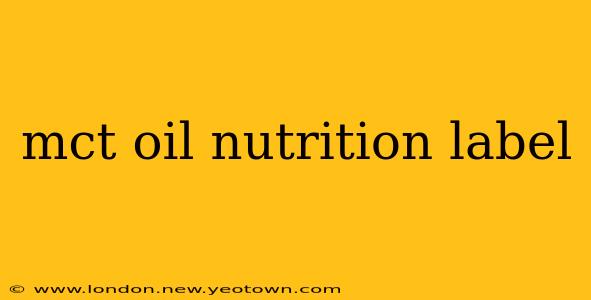The humble MCT oil bottle, often nestled amongst health-conscious pantry staples, holds a potent nutritional punch. But understanding what's actually on that nutrition label can feel a bit like deciphering an ancient scroll. Let's unravel the mysteries and explore the nutritional facts behind this increasingly popular supplement. This journey will illuminate not just the basics, but also address common questions surrounding MCT oil's composition and health benefits.
What are the main components listed on an MCT oil nutrition label?
Typically, the most prominent feature on an MCT oil nutrition label is the declaration that it's 100% MCT oil. Beyond this bold statement, you'll find the standard fare: serving size (usually 1 tablespoon), total servings per container, and calories per serving. The real meat of the label, however, lies in the macronutrient breakdown. Expect to see predominantly fat, with a negligible amount of carbohydrates and protein. The fat content will be further broken down into the different types of MCTs: caprylic acid (C8) and capric acid (C10) being the most common. Some labels may also include lauric acid (C12), though purists often prefer labels featuring only C8 and C10. The percentage of each MCT type varies between brands, so paying close attention to this breakdown is key.
Does MCT oil contain carbohydrates, protein, or fiber?
Carbohydrates, protein, and fiber are virtually absent in MCT oil. This is because MCT oil is derived solely from fatty acids. Its composition consists almost entirely of triglycerides, which are fat molecules. This makes it a valuable addition for ketogenic diets or those seeking a concentrated source of energy. The extremely low carbohydrate content is a key selling point for many consumers.
How many calories are in a serving of MCT oil?
A typical tablespoon (approximately 15ml) of MCT oil contains roughly 120-130 calories. These calories are almost entirely derived from the fat content. This high caloric density is a double-edged sword: a benefit for those needing rapid energy, but a consideration for those watching their overall calorie intake.
What are the different types of MCTs found in MCT oil?
MCT oil is a blend of medium-chain triglycerides, which are types of saturated fat. The most common types are:
- Caprylic acid (C8): Known for its potential antimicrobial properties.
- Capric acid (C10): Often associated with increased satiety.
- Lauric acid (C12): Technically an MCT, but its properties are slightly different. Often found in coconut oil. Many brands focus on C8 and C10 as these are more readily absorbed and utilized by the body.
The ratio of these MCTs can vary greatly between brands. Some focus on high C8 content, highlighting its potential benefits, while others provide a more balanced blend.
Are there any added ingredients in MCT oil beyond the MCTs?
High-quality MCT oil should contain only MCTs. However, some brands may add flavorings or other additives. Always check the ingredient list carefully, looking for anything beyond the specified MCTs. Ideally, a pure MCT oil should contain only the listed MCT types, with no other ingredients.
Understanding your MCT oil's nutrition label empowers you to make informed choices, tailoring your supplement selection to meet your specific dietary needs and health goals. Remember to always consult with a healthcare professional or registered dietitian before making significant changes to your diet, especially if you have pre-existing health conditions.

